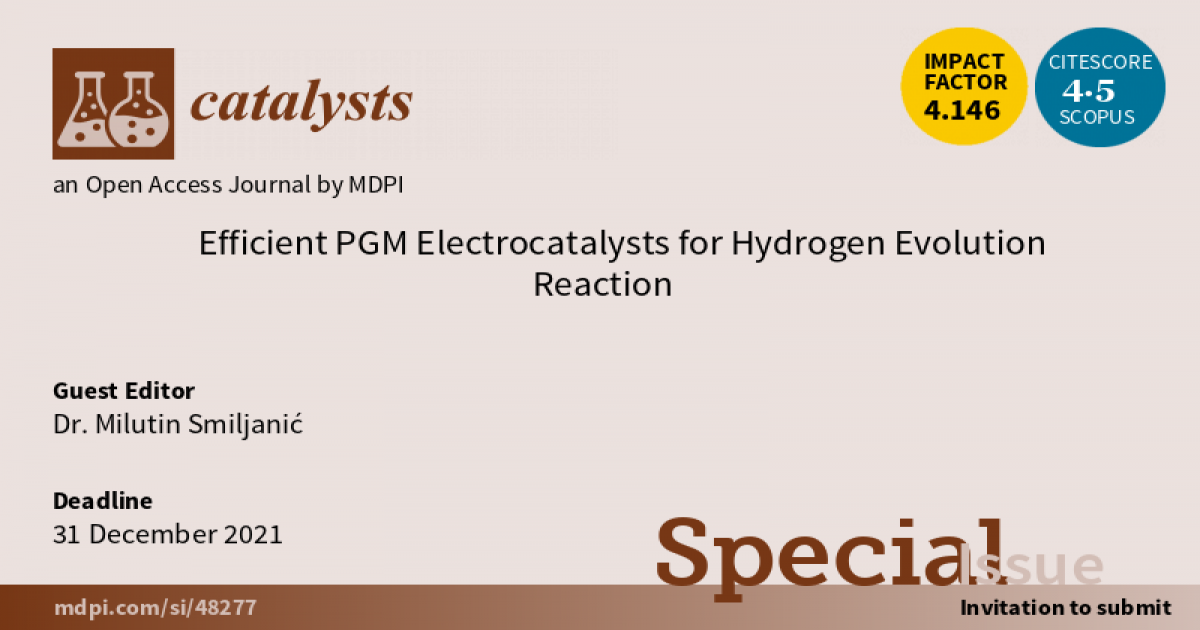Efficient PGM Electrocatalysts for Hydrogen Evolution Reaction
A special issue of Catalysts (ISSN 2073-4344). This special issue belongs to the section "Electrocatalysis".
Deadline for manuscript submissions: closed (31 July 2023) | Viewed by 8081

Special Issue Editor
Interests: electrocatalysis; precious metals catalysts; hydrogen evolution reaction; oxygen reduction; electro-oxidation of small organic molecules; stability of the electrocatalysts; PGM recycling
Special Issue Information
Dear Colleagues,
The expression “hydrogen economy” was introduced half a century ago to describe a scenario in which the main energy carrier is hydrogen, offering innumerable environmental benefits, a secure energy supply, and a global economy. To fulfill this vision, one of the key tasks is to realize hydrogen production independent of fossil fuels. Electrochemical water splitting, in which the hydrogen evolution reaction (HER) plays a vital role, presents an elegant and, more importantly, sustainable pathway for the production of high-purity hydrogen. Therefore, aside from being of broad fundamental and practical industrial importance, HER is regarded as one of the key reactions for electrocatalytic energy storage and conversion technologies. In summary, due to its global importance, HER remains one of the most extensively studied electrochemical reactions.
Platinum is the state-of-the-art electrocatalyst for HER, followed by other platinum group metals (PGMs). The superior catalytic activity of PGMs towards HER is a consequence of optimal hydrogen intermediate species binding energy, which, according to the Sabatier’s principle, must be neither too strong nor too weak. As PGMs are scarce and expensive, reaching economically feasible and sustainable usage of PGM catalysts must be achieved. This primarily implies development of active and stable catalysts with reduced PGM loadings.
This Special Issue aims to collect contributions concerned with recent advances in research on efficient PGM-based electrocatalysts for hydrogen evolution reactions. These include, but are not limited to, fundamental studies on model PGM catalysts, synthesis and characterization of advanced nanoparticle-based PGM catalysts, and the current state of research on novel PGM single atom catalysts.
Dr. Milutin Smiljanić
Guest Editor
Manuscript Submission Information
Manuscripts should be submitted online at www.mdpi.com by registering and logging in to this website. Once you are registered, click here to go to the submission form. Manuscripts can be submitted until the deadline. All submissions that pass pre-check are peer-reviewed. Accepted papers will be published continuously in the journal (as soon as accepted) and will be listed together on the special issue website. Research articles, review articles as well as short communications are invited. For planned papers, a title and short abstract (about 100 words) can be sent to the Editorial Office for announcement on this website.
Submitted manuscripts should not have been published previously, nor be under consideration for publication elsewhere (except conference proceedings papers). All manuscripts are thoroughly refereed through a single-blind peer-review process. A guide for authors and other relevant information for submission of manuscripts is available on the Instructions for Authors page. Catalysts is an international peer-reviewed open access monthly journal published by MDPI.
Please visit the Instructions for Authors page before submitting a manuscript. The Article Processing Charge (APC) for publication in this open access journal is 2700 CHF (Swiss Francs). Submitted papers should be well formatted and use good English. Authors may use MDPI's English editing service prior to publication or during author revisions.
Keywords
- electrocatalysis
- hydrogen evolution reaction
- platinum group metals
- model PGM electrocatalysts
- PGM nanoparticles
- PGM single atom catalysts





